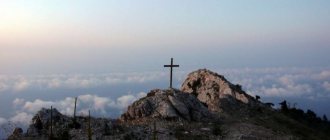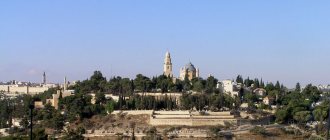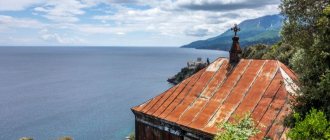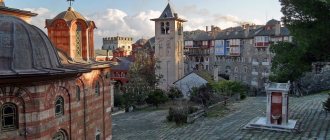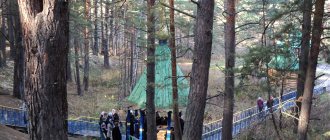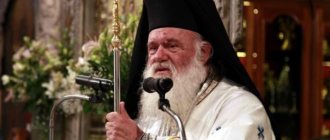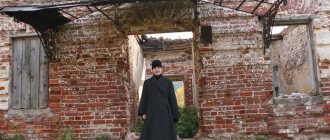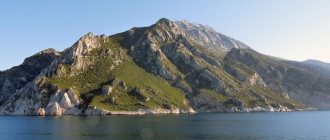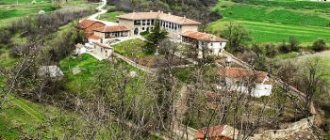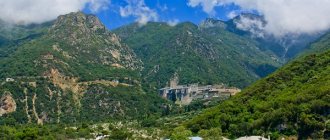World of Adventures - Dohiar Monastery Holy Mount Athos. Film4 from the cycle: “History and shrines of Athos”
Monasteries of Holy Mount Athos. A film about the spiritual connection between Moldova and Russia with Holy Mount Athos. Film 3 from the series: “History and shrines of Athos.” The entire series of films: https://mir-prikliuchenii.com/movies
Tags: Miraculous icon “Quick to Hear”. Celebrating the Nativity of Christ on Mount Athos. Christmas service at the Dokhiar Monastery of Holy Mount Athos. Panigir in the Dohiar monastery. Paisiy Svyatogorets. Paisiy Velichkovsky on Mount Athos. Cell Panaguda. Conversations with Athonite elders. Athos Peninsula. Easter on Holy Mount Athos. Celebrating Easter on Mount Athos. Hegumen of the monastery Dokhiar Gregory. Monastic Republic. History of Athos. Monasteries of Holy Mount Athos. Who founded monasticism on Athos. Afanasy Afonsky. Orthodox monasteries. Athos monasteries. Daphne's pier. Orthodox faith. Orthodoxy in Greece. Life of Athonite monks. History and shrines of the Dohiar monastery. Miraculous icons on Mount Athos. Orthodoxy on Holy Mount Athos. Holy relics on Mount Athos. Relics of Saints on the Holy Mountain. St. Andrew's Skete. Holy relics of the Apostle Andrew the First-Called. Shrines of Athos. Athonite monks. Monks of the Dochiar Monastery. Monks of the Vatopedi monastery. Monasticism on Mount Athos. Holy faith. Monastic library of the Dohiar monastery. The sacristy of the Dohiar monastery. Dochiar Monastery Museum. Shrines of Athos. Monastery of Dohiar. Monastery of Kutlumush. Vatopedi Monastery. Elias Monastery on Mount Athos. Miraculous icons of the Dohiar monastery. Miraculous icon “It is worthy to eat.” Miracle-working icons of Athos monasteries. Holy relics of the Dohiar monastery. Shrines of the Dochiar Monastery. Karulia. Icons of Athos. Monks of Athos. Icons of Holy Mount Athos. Miraculous icons of Athos. Abbot of the Dokhiar monastery. Procession with the miraculous icon “Quick to Hear”. Monasteries on Mount Athos. Athos monasteries. The best films about Athos. The best films about Holy Mount Athos. Interview with the abbot of the Dokhiar monastery, Archimandrite Gregory. Pilgrimage to Holy Mount Athos. The lot of the Mother of God. Connection between Moldova and Athos. Rulers of Moldavia and Holy Mount Athos. Elders of Holy Mount Athos. Athonite elders. The most beautiful places on Earth. The most beautiful places in the world. The most interesting places on Earth. The most interesting places in the world.
Tags: Athos mountain Greece. The orthodox monasteries at mount Athos. Orthodox icons. The life of the orthodox monks. Monastik life in Athos. The orthodox monastery Pantokrator. The orthodox monastery Vatoped. Holy mountain Athos.
Rare video: the most humble elder of Athos
Elder Gregory is a unique example of a true Athonite elder who rejected all earthly temptations, and even having headed the monastery on the Holy Mountain, was not seduced by an important position and fame, but preferred to live on an equal footing with all the other monks. (You can read more about Elder Gregory in the Faces of Athos section of our website)
He could rarely be seen in the rich ceremonial vestments of the abbot of the monastery; he did not wear expensive jewelry and did not want to use precious staves.
A rebel by nature, the elder more than once experienced the wrath of archaeologists, who scolded him for deciding to destroy part of some ancient wall that interfered with the monks in their daily movements, or for the unheard-of idea of installing two columns with sculptures of the Archangels Michael and Gabriel.
Archimandrite Gregory was born on the island of Paros and was related to the famous Athonite elder Joseph the Hesychast.
Before his arrival on the Holy Mountain, Elder Gregory was a monk on his native island and on Patmos; managed to be abbot of two monasteries; was the spiritual child of 2 modern Greek saints Philotheus Zervakos and Amphilochius Makris.
Elder Gregory lived in the monastery for 65 years; he took monastic vows on January 1, 1967 from Elder Amphilochius of Patmos.
A few years later, the elder arrived at the Dohiar monastery, where he was soon elected abbot. It is worth noting that the monastery was in a rather deplorable state, it began to collapse, and the brethren were small in number.
Elder Gregory always had a bright and independent point of view even on the most delicate topics. So, in one of his interviews, he said the following about his abbess on Holy Mount Athos:
“Before I became the abbot of the Dochiar monastery, they poked my nose into every mop that was left in this old monastery from the previous managers. It had to be that way, I'm glad they treated me like that. I took the hardest steps in my life to ascend the throne of Dochiar, after 10 years as abbess in Greek monasteries.”
The elder preferred to wear old, inconspicuous clothes and always behaved very modestly. Despite his position, he introduced himself as a hieromonk and asked to remember “the robber Gregory” in prayer.
The abbot of the Dokhiar monastery spoke about monasticism as follows:
“... The inner life of a real monk is not visible to others, it is hidden and will be revealed only in the Kingdom of Heaven. A monk, as theologians say, is a prophet who speaks with his life about the last days. Therefore, at the burial of a monk, his face is covered with a veil, and his whole body is covered with a great schema, just as the flag of a country covers the bodies of soldiers who served it and fought for it to death.”
Elder Gregory always had a bright and independent point of view even on the most delicate topics. So, in one of his interviews, he said the following about his abbess on Holy Mount Athos:
“Before I became the abbot of the Dochiar monastery, they poked my nose into every mop that was left in this old monastery from the previous managers. It had to be that way, I'm glad they treated me like that. I took the hardest steps in my life to ascend the throne of Dochiar, after 10 years as abbess in Greek monasteries.”
“I praise the Lord and His Most Holy Mother for the fact that my monastic life, which I always shared with my brethren, was full of trials. We learned everything from our own experience, and therefore, as a leader, I do not feel guilty. We had to live on the seashore, on the plain, in the mountains, and now in the foothills of Athos.”
Russian screenwriter Ilya Avramenko recalled the elder this way:
“Geronda Gregory used to bless with a slap in the face. It was believed that the stronger the better. His hand was very heavy – at least that’s the impression I got. I remember this now, and my cheek begins to burn. In some cases, he could “bless” with a staff - if, for example, someone in his presence was sitting cross-legged (because that’s how harlots used to sit).”
“- There were very interesting conversations in Dohiara. Father Gregory was such a flint of faith! The elder was so humble! When we first arrived, we entered the territory of the monastery, there was a man walking around covered in rags, and probably 100 cats were running around him. Everyone's tails are like a pipe! And there are also small dogs flickering around. We go to him, and he:
“Yes, now the monks will come, everything will be ... - but he seems to put himself in nothing.”
“And then, I remember, we went to the meal, and lo and behold, at the head of the table was the same monk... Only the cassock he was wearing was different, not his work one. This, it turns out, was the abbot. Geronda Gregory. He started talking, and everyone just opened their mouths. He told us such things! I haven't read this in any books. This is such a spiritual person. Greece, through his prayers alone, was kept from much evil. And how he loved Russia!”
general information
Monastery of Simonopetra
The monasteries of Mount Athos in Greece are a place of pilgrimage for thousands of guests. However, women are prohibited from visiting the mountain. There is another legend about this. The Virgin Mary, seeing the mountain, was fascinated by the local nature and asked God for it. Since then, no woman has been able to set foot on the slopes of the mountain. The myth is supported by a decree of the Greek President, according to which arrest and imprisonment are provided for a woman who sets foot on Mount Athos.
Athos is a modern state with its own Charter and approximately 2,000 monks who pray day and night for the salvation of humanity. Monks are forbidden to eat meat, smoke and wear any clothes other than church clothes.
Career
The capital is Karye, where the Museum of the History of Christianity is located, where ancient manuscripts and rare icons are kept. Simonopetra is recognized as the most beautiful on Mount Athos in Greece - a seven-story building located right on a steep slope, which gives the monastery special grandeur.
One of the features of the monastic republic of Athos is the calculation of time. Here they have their own method of determining the beginning and end of the day; in some places they are guided by sunset and sunrise, and in others by the time zone of Greece.
The invisible elders pray on Mount Athos for the sinful planet
Writer Yuri Vorobyovsky published the book “Invisible Elders” about the miracle of Athos - the invisible elders
“Ascetics who received from God the gift of becoming invisible is the ancient and most mysterious tradition of the Holy Mountain,” says the writer, who has been visiting Athos for many years.
BATTLE WITH Evil Power
CORR: Why should they be invisible?
VOROBEVSKY : This is the elders’ response to the curiosity of the all-pervading world. They don’t have a minute for empty communication. As long as they keep, even in sleep, their constant, self-propelled prayer, the world stands in its place. When the last times come, they will rise to the top of Athos, to the small temple of the Transfiguration of the Lord. There they will serve the last liturgy before the End of the World.
So says the legend.
I first heard about the invisible elders in 1997 - my first pilgrimage to an Orthodox monastic republic. On a warm evening, we sat on the balcony of the archondarik (hotel) of the Panteleimon Monastery with the American Eugene, a descendant of emigrants from Russia. The black silk of the sea is decorated with a silver braid of a lunar path. From the side of the port of Daphne, a searchlight searches the water - the Holy Mountain is protecting itself from prying eyes. Evgeniy is a frequent visitor to Mount Athos. It was he who spoke about the mysterious ascetics. Not only about legends, but also about his meeting in the Athos forest... A mysterious gray-bearded monk appeared in front of him out of nowhere - and at the right moment. The American was lost and in despair. The hermit showed him the way. Evgeny turned to thank him, but there was no one on the path. It was as if a monk had evaporated.
Intrigued by the American, I began to ask about the secret brotherhood of the Holy Mountain people themselves, including the author of several books, the Greek monk Blasius. There have been a lot of stories.
- Interesting interesting!
— At the end of the 19th century, the librarian of the Russika monastery, Father Panteleimon, wrote down testimonies about the elders. In 1835, hunters caught wild goats under Mount Athos. One day at dawn, walking along the rapids, they came across a naked old man emerging from an inconspicuous cave. Surprised, they started a conversation: “Bless, father.”
- God bless.
- How are you doing?
- Thank the Lord. How is the Holy Mountain located?
- Safely after the filthy Turks.
- Which Turks? – now the old man was surprised.
- Which ones? Those who lived on Athos as a result of the Greek uprising.
—What uprising?
“Don’t you know that we Orthodox Christians shed our blood for ten years to overthrow the Turkish yoke?”
- No, I didn’t know. There are seven of us here, we don’t go anywhere...
At the monastery of St. Anna, the hunters told about the meeting. Many holy fathers gathered and, forgetting about old age and infirmities, picking up their robes, they set off to look for the elder. To no avail...
The doctor of the Great Lavra, Father Athanasius (Kambanos), called their habitat the sparsely populated, densely forested spaces between the monasteries of Little St. Anna and Glossia. The few who have been privileged to see these hermits describe them as magnificent, almost fleshless ascetics, completely naked, but shining with the robe of Divine grace. Father Athanasius also referred to the testimony of Elder Anthony from the monastery of St. Peter, who came to the Lavra, fulfilling the instructions of the invisible ascetics: “Go and tell the Lavra doctor that he will soon get sick and die, so he must get ready.”
And indeed, soon Father Afanasy fell ill and, without any serious illness, fell asleep in eternal sleep. Before his death, he published 80 years ago in the magazine “Svyatogorsk Library” information that these holy ascetics exist and wander in the deserts of Athos - for the glory of God and for the spiritual benefit of the inhabitants of the Holy Mountain.
- Why are they naked, Yuri?
- Over many years of wandering, living in narrow caves, clothes are torn, and such great ascetics, as you understand, no longer need new ones. As the hermit's clothes are torn, the soul becomes increasingly freed from bodily bonds and unites with God. The naked elders are naked as if in an image of deliverance from coarse flesh. So they are the chosen ones in their true form. Or lost, lost at the right moment to help.
Papa Kral, a hermit who labored in the rocks of Athos for half a century.
Holy Mountain Father Jacob labored for many years in the monastery of Kafsokalyvia. As a novice, he constantly came at night to the cathedral church - kyriakon - and prayed for hours before the icon of the Holy Trinity. One night, on a full moon, I saw a magnificent hermit, completely naked, with long hair and beard as white as snow. The elder raised his right hand and made the sign of the cross over the locked inner doors of the temple. They opened by themselves. A mysterious stranger entered the church and kissed the icons with reverence. When the hermit left, the inner doors of the temple began to move again and closed themselves. The shocked novice secretly followed him. They rose higher and higher, to the top of Mount Athos. Having reached the cell of Panagia, the hermit went inside. Jacob caught up with the elder and, throwing himself at his feet, with tears begged him to show mercy and keep him as a novice. “Child, you cannot endure this feat,” answered the elder. “Without God’s grace it is impossible to bear the burden of life in this place.” Return to your elder, remain in obedience to him, and you will be saved...”
- What kind of feat was he talking about?
- A feat that is difficult to bear is, of course, not only the strictest fasting and the winter cold of the highlands. The main feat is the endless spiritual battle that is waged in the desert. When you are alone with a demon. Several pagan temples are known on Mount Athos, dating back to the 6th-4th millennium BC. For example, the huge picturesque rock Idolio, that is, Idol. It is not recommended to visit it without special blessing. As you approach the temple, the path is shrouded in fog. This is a cloudy area. The whole body is saturated with cold, all-permeable moisture, and fear creeps into the soul. At the intersections of the paths converging to Idolio there are crosses. Like road signs: the exit of evil spirits from the gorge is prohibited... At the top is a marble slab, about two by three meters. Human sacrifices were made on it in ancient times. On the sides of the slab there are drains carved for blood, which was collected in a huge stone bowl. Here you feel with every fiber of your soul: the dark energy has not gone anywhere. Soldiers of Christ - hermits - come here to fight evil spirits. Give battle to the devil in his very lair. This is the spiritual tradition. Many Athonite monasteries, including the Lavra founded by St. Athanasius, stand on the site of ancient temples. So each such monastery is also a symbol of the spiritual victory of Orthodoxy.
BROTHERHOOD OF THE SEVEN
— Hieromonk Athanasius Simonopetris, a disciple of the Great Geronda (elder) Paisius the Holy Mountain, recalled how he once came to his cell of the Holy Cross on the eve of Easter. It was Good Friday 1978.
- Geronda, I have long wanted to ask: do naked elders exist?
He took my left hand, as he usually did, and put his other hand on my back. He shot a glance and asked: “And you, blessed soul, what do you think about this?”
Elder Paisios
“If the Holy Spirit blessed them to be in the old days, why shouldn’t they be now?”
- If they ask you, then say that they exist...
— They told how twelve “invisible” naked elders were seen in St. Anna; in Malaya Anna they said that there were nine of them.
- No, there are not twelve or nine of them, but seven of them are hermits.
- Where are they?
“They wander near the top of the Mountain. They have a special gift from God and a prayer such that no one sees them. They may be near you, but you won't see them. That's why they are called invisible. This is not an allegory...
— What do they eat in winter?
- If they are completely naked in winter, without clothes, what’s the problem with them getting soaked in something?! Okay, go - go, that's it!
- No, one more question...
- Eh, blessed one, what kind of curiosity is this? God does not want to reveal them to the world...
- I won’t leave until you say something more precise...
- Fine. I know only four... Every five years I see one of them, Father Seraphim, and we talk... He comes here just at this time, on Easter... Where are you? (He leaned forward a little, as if towards someone present.) Where are you, my blessed one? And, turning to me: “Don’t be so surprised by naked ascetics.”
- Why, father?
“Because on the Holy Mountain there is a state of greater holiness.”
— Yuri, there are legends about eternal lamas, either praying or sleeping in the secret caves of Tibet. Are the invisible elders of Athos also immortal?
- No.
“Then how is the secret brotherhood of the seven preserved?”
- Geronda Paisiy Svyatogorets explained this way: “When one of them dies, they know where a suitable person is located who can withstand severe asceticism, and they call on him to replenish their number.”
THE ELDER APPEARED
“Paisiy Svyatogorets himself wrote how in his youth he got lost on the way to the monastery of St. Anna and met a hermit whose face literally shone,” writer Yuri Vorobyovsky continues the story. — He looked about seventy years old, he was wearing a cassock made of a material similar to canvas or tarpaulin, all faded and torn. Apparently, he had no contact with the human world for many years, but not so long ago that his clothes were completely rotten. The holes in this robe are filled with sharp splinters. A thick chain hung around his neck, holding the box at chest level. Apparently there was some kind of shrine in it!
Before Paisius could ask a question, the hermit said: “My child, this road does not lead to St. Anne.” And he showed me another path. His appearance was like that of a saint!
“Where do you live, old man?” - Paisius asked the hermit.
“There somewhere,” he pointed with his hand to the top of Mount Athos...
Of course, this is not a matter of finding a path. The very appearance of the holy elder is a laconic and miraculous instruction on the true path. Judging by the memoirs of Paisius the Svyatogorets, he met this amazing hermit precisely when he was looking for spiritual guidance. In his search, the young monk walked along inconspicuous paths for so long that he lost count of what day it was today. The anchorite answered this question by taking out notched sticks from his bag.
There is such an episode in the biography of Paisius himself. He sits on the side of the path and talks with one pilgrim. A large group is approaching them, clearly heading towards the elder’s cell - so what? Everyone passes literally two meters away, without noticing those sitting. The interlocutor of Paisius Svyatogorets testified that at that moment they were clearly invisible to the others. The elder even told the pilgrim to stop whispering - for fear that they would be heard, come up and prevent the conversation from being completed. He began to speak in a normal voice, but those walking not only did not see them, but also did not hear them.
Apparently, Paisius himself possessed such an amazing gift of invisibility, but rarely used it. The Lord revealed it to comfort people. Made him an OBVIOUS old man. Revealed to the world. He could also be called a comebacker. Those who have returned for humanity from a special prayer-timeless space. The saint's prayer transcends time. She is in eternity, which is, as it were, always present; the past of the present and the future of the present. In prayer, when an ascetic is caught up in this space, upon his return he is surprised to see how much time has passed while he was “absent.” This is how a person becomes eternal for a while. From this eternity comes everything “unusual”: the superhuman powers of ascetics, the power given to them over space and the ability to look into the “future of the present.” God knows, but when a monk stands in front of you and you don’t see him, perhaps at that time he is in eternity?
So are there still elders on Mount Athos? Any Athonite pilgrim is constantly asked about this. But before you get the answer, you need to grow to the question. Thank God that he is asking himself. The question does not belong to idle curiosity. The soul of an Orthodox person understands: the main events and the main people for us are not those who are shown on TV. The Universe still flies in its orbit not through the efforts of the Nobel Peace Prize laureates...
The “powers that be” start wars by showing reporters a wise expression on their faces. Images, put on over emptiness, gathering in their circle, laugh at the stupidity of the crowd... But fateful events happen somewhere. Real people live somewhere. In some kind of concentrated silence, away from camera flashes. Where, if not on the mysterious Athos - with its legend about the invisible elders?! Where, if not in the temporary space of self-propelled prayer?!
THE SECRET OF FREEDOM
— It was the revolutionary year 1968. The world was worried about grandiose events. For some, the “Prague Spring” and the student revolution in Paris, for others, the opening of the Olympics in Mexico City and the world tour of the Beatles... And in the wretched Cross cell, which was hidden in the thickets not far from the Stavronikita monastery, lay the Russian schema-monk Tikhon. Didn't get up anymore. One day he called to his disciple: “Here now, my child, was the Mother of God with Saint Sergius and Saint Seraphim.”
The student asked: “What did the Mother of God tell you?”
“The feast of Her Nativity will pass, and after it She will come and take me to Herself.”
On the day of the panigir (celebration - Greek), the elder said to the novice: “Tomorrow I will die and I want you to bury me. And so I want to bless you.” For three hours he held his hands on the head of his spiritual child. Fingers that have made millions of signs of the cross. Palms, rough from touching the floor during countless prostrations and worn with steel chains on the Karuli rocks, where the elder labored in a cave for a decade and a half (only by holding on to these chains can you climb to the cave carved into the rock!) What did this long touch of the elder’s hands mean? to the novice's head? What energy did it transmit? What experience? What did Father Tikhon silently pray for?
Then he gave such a touching parting word: “You pray for me, and I will come and see you every year. If you stay to live in my cell, I will be very happy. But let everything be as God pleases, my child. You see, I have provisions for you here for three whole years,” and he pointed to the canned food: six boxes of sardines and four boxes of squid. All these supplies were brought to him by one of his visitors a long time ago. They remained untouched.
“For me, these canned goods would only be enough for a week,” thought the student Paisiy... Yes, it was he, the future famous elder Paisiy Svyatogorets. Then he testified about Father Tikhon: “This old man made his life simple... He was free from any inconvenience, for what we call convenience today are in fact inconveniences. Convenience is when you simplify your life and limit yourself to what is necessary. Then a person is liberated...
An unknown Russian monk conveyed the secret of freedom to a Greek ascetic. A world that fought for racial freedom and rejoiced that it was in 1968 that the word “Negro” began to be replaced by the word “dark-skinned”; a world that was waiting for Czechoslovakia to finally be freed from the “Soviet yoke”; the world, which admired the heroism of the Cubans who defended their freedom on Playa Giron, knew nothing about this event. And I didn’t want to know...
The Russian elder departed, and the Greek monk received charisma from him, the gift of the Holy Spirit. It is conveyed exactly this way: schema-monk Tikhon died in his arms... As many people as possible would be connected by such a supranational kinship!
— Yuri, in 15 years of traveling to Mount Athos, I understand that you have never met the invisible elders. Although I visited all the secluded corners of the Holy Mountain. To be honest, do you believe in them?
- There are elders! Eat! Personally, I don’t necessarily have to look for those very secluded caves where seven unknown people labor. Those interested in semi-spiritual speleology and semi-prayerful rock climbing are directed to the portal isihazm.ru. To descriptions of expeditions, whose participants claim that mysterious caves were found by them. And even that these secluded shelters are inhabited today.
I don’t know why worldly people need to fight their way through the blessing of invisibility! For monks who already have spiritual experience, it’s a different matter. They need to learn more. But their Lord most often does not lead to the desired meetings.
Father Alexander from the Kukuvino cell gives the author a lightning rod from the former Transfiguration Church, which is on the top of Mount Athos.
“Elder Joseph, together with Father Arseny, diligently searched for naked ascetics, hoping to receive instruction from them, but they did not find them. Later they heard that they came to Father Kosma, whose cell was in the monastery of Panagia. Naked ascetics came to this man every Saturday for many years and received communion. At some holiday, Father Kosma, having forgotten himself, let slip about this secret to other fathers. The next Saturday, after the naked ascetics came and took communion, they told him: “You opened us, so you won’t see us again.” Father Kosma fell at their feet and asked for forgiveness. They answered him: “You are forgiven, but after what you did, you will not see us again.”
...And I saw one invisible old man! However, he was only twenty-five years old, but old age is not an age category, nor is it a mandatory gray beard. In 1997 I met the Bulgarian monk Anthony. Zograf talked with him in the monastery. What is its “invisibility”, you ask! The fact of the matter is that there are such ascetics on Athos who are visible to everyone, but the secret of their spiritual experience remains hidden. You see in front of you a simple monk, but you don’t see an old man in him... Three years after the death of Schemamonk Anthony, who died in a spiritual battle with the demonic world very young, according to Athonite custom, his bones were dug up. The ascetic’s skull turned out to be amber-yellow. Such, they say on the Holy Mountain, are only found among saints. Little by little the secret of his feat began to be revealed. But more about this in my new book.
In 1997, we met Schemamonk Anthony; after his death, his skull turned out to be yellow, as if waxy (a sure sign of an ascetic holy life on the Holy Mountain).
Enough said. I knew a saint! So Athos consoled me once again.
Stills from Yuri Vorobievsky's documentary "Invisible Elders"
The Athos peninsula is the easternmost of three separate parallel branches or "fingers" of the Halkidiki peninsula, of which there are three in total - Kassandra, Sithonia (central) and Athos or Holy Mountain.
Athos (Άγιον Όρος) is considered one of the main holy places of the entire Orthodox world , revered as the Lot of the Mother of God. Holy Mount Athos is an autonomous part of the Greek state and includes twenty monasteries and other monastic institutions.
History of Athos
Athos was first mentioned during the Persian campaign against Greece under the leadership of Mardonius (Μαρδόνιου), in 493 BC. While sailing around the peninsula, the Persian fleet encountered a storm and suffered a terrible disaster; the invasion of Greece was thwarted.
Ten years later, the Persian king Xerxes repeated the task, but in order to avoid the danger of a new catastrophe, the Persians dug a canal in the narrow part of the peninsula 1.5 kilometers long, 65-100 feet wide and 6-10 feet deep.
The Bay of the Holy Mountain is also associated with the loss of the fleet of the Spartan king in 411 BC.
Since 1988, Mount Athos has been included in the list of World Heritage Monuments.
In 2021, Athos celebrated its millennium.
During the Byzantine period, hesychasm (silent prayer) flourished on Mount Athos; during this period, monasticism flourished with the support of the Byzantine emperors, and the number of monks increased significantly.
During the Ottoman yoke, the economic situation of the monasteries worsened due to heavy taxation, some monasteries became empty, and the monks left.
During the revolution in Chalkidiki, there was a really big disaster on the mountain of Athens. Women and children took refuge on Mount Athos, but Turkish troops killed the monks, women and children and destroyed valuable treasures.
On November 2, 1912, the Greek Navy, led by the battleship Averof, landed troops in the port of Karye (Καρυαί), which hoisted the Greek flag on Mount Athos and proclaimed its annexation to the Greek state.
During the Second World War, the Athos leadership, trying to preserve the treasures of Athos and its integrity, and also not to fall under the influence of the Bulgarians, asked Hitler to take Athos under his protection. Flattered by their request, Hitler issued an order banning Bulgarian and German troops from entering Mount Athos.
In the 1970s, after a new regeneration was observed on the peninsula, many monks seeking an ascetic life in the only living monument in the world greatly increased the population of Athos.
Currently, there are twenty monasteries , cells, monasteries, kalivas on Mount Athos, and hermits live in caves.
According to the law, women are prohibited from entering Mount Athos , and the construction of new monasteries is also prohibited.
Mount Athos does not have asphalt roads, but there is an extensive network of forest roads and paths.
Reminder to the traveler - pilgrim to Athos.
A unique chance is given to pilgrim travelers, regardless of religious belief and personal worldview, to experience the life of monks.
The first thing you must do is to obtain permission to enter Athos, i.e. Diamonitirion (ΔΙΑΜΟΝΗΤΗΡΙΟΝ), it is issued in Ouranoupolis or in the city of Thessaloniki (tel. +30 2310 252578) at the ΓΡΑΦΕΙΟ ΠΡΟΣΚΥΝΗ office ΤΩΝ (graphic proskiniton, tel. + 30 2310222-424).
The telephone number of the Russian Monastery of St. Panteleimon may be useful to you: +30 23770 23201, e-mail: This email address is being protected from spambots. Javascript must be enabled in your browser to view the address.
The host of pilgrims, the archondaris, will tell you about all the rules of behavior. Don’t forget that clothes should be modest (long-sleeved shirt) and shoes should be comfortable, as you will have to walk on mountain roads. Food, either material or spiritual, is not sold here.
Holidays on Mount Athos:
In addition to monastic life, there is also secular life on Mount Athos; you can come here on vacation, as there are excellent beaches, taverns, cafeterias, hotels for every taste. The only thing you won't find here is nightclubs.
Where to stay:
At the entrance to the peninsula, there are the popular resorts of Ouranoupolis (Ουρανόυπολης) and Tripiti (Τρυπητή). Ouranoupoli is a city with good tourist infrastructure: shops, hotels, cafes, bars and restaurants. Tripiti is a very beautiful area, with lush vegetation, beautiful beaches and turquoise waters. This is an ideal holiday destination for those who want to avoid the crowds, but at the same time want to be close to entertainment venues and enjoy Greek cuisine. Tripiti offers a variety of hotels, rooms, studios and suites that will provide you with comfortable accommodation. Beaches on Athos:
Swimming is not allowed on the shores of Saint Athos. We recommend you visit the beaches in the village of Ouranoupoli and Tripiti, as well as the beaches of Alexander, Philip, St. Paul, Komitsa, Xipropotamos (Ξηροπόταμος), Dzafa (Τζάφα), Voulitza (Βουλίτσα) and Iviritiko (Ιβηρίτικο). The islet of Ammouliani (Αμμουλιανής), which is located opposite Ouranoupoli, has excellent beaches with fine sand and turquoise water. You can get to Ammouliani by ferry by sea or rent a boat from Ouranoupoli. Sights of Athos:
During your stay on Mount Athos, we recommend that you visit the archaeological and historical monuments of the region. In the village of Ouranoupoli, you will see the Byzantine tower of Prosphoria (Προσφορίου), the ruins of the Abbey Castle of the Franks (Φραγκόκαστρο) and the Museum of Christianity. Nearby, in the village of Nea Roda, you can visit the Xerxes Canal and the archaeological site of Sani/Ouranoupolis. In the village of Ierissos (Ιερισσό) there are archaeological excavations of the ancient city of Akanthus (Ακάνθου) and the Byzantine tower of Kronos (“Κρούνος”). How to get to Athos:
You can reach the Athos peninsula in Chalkidiki by bus from Athens or from Thessaloniki: Athens BUS STATION: Tel. +30 210 5154800 BUS STATION in Thessaloniki: Tel. +30 2310 9244444 Polygyros Bus Station (Πολύγυρου): Tel. +30 23710 22309 You can also take a plane, ferry or train to Thessaloniki and then take a bus to Mount Athos (Ουρανούπολη/Ιερισσός).
Useful phone numbers for Athos: Macedonia Airport Tel. +30 2310 985-000 Port of Thessaloniki Tel. +30 2310 531-505 Thessaloniki Railway Station Tel: +30 2310 517-517 Athens International Airport "Eleftherios Venizelos", Tel: +30 210 353-0000 Port of Piraeus Tel +30. 210 422-6000 Athens Railway Station Tel. +30 210 529-7777 Port of Ouranoupolis Tel. +30 23770 71248 Port of Ierissos Tel. +30 23770 22576
Phone numbers of monasteries on Mount Athos: Monastery of St. Dionysus: Tel. +30 23770 23686 Monastery of St. Panteleimon: Tel. +30 23770 23201 St. Paul's Monastery: Tel. +30 23770 23208 Vatopedi Monastery: Tel.+30 2377023219 Gregory Monastery: Tel.+30 23770 23218 Δοχειαρίου (Dohiar): Tel. +30 23770 23245 Monastery of Εσφιγμένου (Esphigmen): Tel. +30 23770 23796 Zografou Monastery: Tel. +30 23770 23247 Ιβήρων Monastery (Iversky): Tel. +30 23770 23248 Monastery Καρακάλλου (Karakal): Tel. +30 23770 23225 Monastery Κασταμονίτου (Kostamonit): Tel. +30 23770 23901 Monastery Κουτλουμουσίου (Kutlumush): Tel. +30 23770 23226 Panagia Lavra Monastery: Tel. +30 23770 23761 Monastery of Ξενοφώντος (Xenophon): Tel. +30 23770 23249 Monastery of Ξηροποτάμου (Xiropotamus): Tel. +30 23770 23251 Monastery of Pantokratoros: Tel. +30 23770 23253 Monastery of Simon Peter: Tel. +30 23770 23254 Monastery of Σταυρονικήτα (Stavronikita): Tel. +30 23770 23255 Monastery of Φιλοθέουт (Philofey): Tel. +30 23770 23674 Monastery Χελανδαρίου (Halandar): Tel. +30 23770 23281
about pilgrimage trips to Mount Athos here
“Where are you, Adam?”: why you should watch a new film about Athos
Estimated reading time: less than a minute.
Film "Where Are You, Adam?" Alexandra Zaporoshchenko talks about the life of the monastic community in the ancient monastery of Dochiar on the western coast of Mount Athos, one of the peninsulas of the Aegean Sea. The film presents pictures of nature, images of the novices of the monastery, but the center is Abbot Gregory, as stated on the film’s website: “whose many years of experience in nurturing awarded him with a deep understanding of the human soul and its desire to return to the state characteristic of the human nature of Adam before the Fall.”
Everyone has their own path and their own story. At times it seems to me that a person of art should remove the personal, remove “himself” from his works, depending on the genre, of course. The filmmaker coped with this task. The film "Where are you, Adam?" Ukrainian director Alexander Zaporoshchenko about the life of the community of the Athos monastery of Dokhiar... but is that all it is?
I was amazed that I saw almost nothing of what I expected, and this turned out to be a path to delight. There were no rosaries, prayers, or monks standing for many minutes in front of icons. No, there was prayerfulness, but without cliches: no pretentiousness, nothing for show. Even the musical score is unusual. In the first half of the film there is almost modern music, and towards the end there is the playing of the monk Abel on the piano.
The main character of the film is Archimandrite Gregory (Zumis), abbot of the monastery. He's completely unpredictable. When they hit the testicles on Easter, he becomes mischievous and does not allow the old monk to be hit again. He notices a dog that constantly runs around him. He says that you need to look for the dispelling of grief in a cat, an animal, a flower. But suddenly he cries and admits: “There wasn’t a day for me when I didn’t repent of two things: first, that I became a priest. And secondly, that he agreed to be abbot.”
From that moment on, the film becomes an event in my personal life. Everyone has their own path and story. My story, I hope, has not yet been completed, but the theme of monasticism occupies its special place in it. There was a time when I thought about monastic life and realized that this was not my path. I turned so far from this path, and it was so difficult, that while looking at the picture I was afraid: I wouldn’t be able to finish watching the film because of my personal experiences. And suddenly Abbot Gregory speaks about the tears that wash his entire service, covering his face with his hand. But then his thoughts turn to Christ and admits that only He is able to save him. The question of the purpose and providence of God deeply concerns not only my heart. It’s like a million stones fell from my shoulders: the man said the most important thing for me.
How did this happen? According to the producer, Protodeacon Alexander Pliska, this film is like an icon with a reverse perspective. That is, the viewer stands in the center and, contemplating the icon, he simultaneously sees himself. Each person may find something different in this standing, but this is the principle.
Episodes with the old man alternate with seemingly completely unnecessary shots. Pictures of stones and the sea, picking olives, going out into the fields, the free breathing of a person who lives in a different rhythm, not urban, not secular. And unexpectedly - a long scene with tonsure as a monk.
At first you don't understand anything. A stocky young man in a white shirt, and there are monks around, and singing is already spreading through the temple. A handsome, one might say, pleasant man. And so they take him - where? For what? And then the words sound: “Christ stands here invisibly” and “Look, no one is forcing you to become a monk...” And again we see that the abbot is crying. What do these tears mean? In the film, the elder says that each of the monks is his cross. Maybe now the burden is getting heavier?..
The confessions of Father Gregory and his image form the dramatic hub of the narrative. Although I wrote about tears and repentance, Father Gregory himself is very different. There are scenes where he is completely open, open like a child and admits to something very personal and deep. There are sentimental, and there are smiles that are not devoid of humor. Before us is a living person who knows: there are those who gossip about him and do not want to say a kind word to him. But he doesn't reject them! It would seem so easy to give up everything: “If I had a flute, I would now be playing somewhere on the top of the mountains and would be free.” But he is a warrior who remains in his place. People are important to him, even those who might make him sad. But nearby are the Archangel Michael, the saints from the icons in Dochiara, the Mother of God, and Christ himself. Where should he go?..
The film expresses the idea almost without equivocation: we don’t want to show exemplary monks. This is a film about the resurrection and salvation all , such as we are, about the salvation of everyone. Right here is Christ. He forgives and saves. And a shot of a ruin, the fragments of something large broken. Just wreckage, but very, very beautifully shot! You look at them and think: even if your life is ruined, in reality it is not. Because there is God. And that means there is hope.
After watching it, I stood on the street and for some reason remembered “Sin” directed by Andrei Konchalovsky. Why? Over these two years, I have watched a lot of films, primarily documentaries, in which the adjective “Orthodox” is present. There really were clergymen, pictures of beautiful temples, almost certainly Greek or Russian chants, some kind of historical information. But my heart and mind were missing something, with all due respect.
You see, it is no coincidence that the same “Thomas” is called “an Orthodox magazine for doubters.” A person (whether he is a believer or not is unimportant) still cannot help but doubt and think. At least about your own actions, sins, your future. Some time ago, a film by Konchalovsky, not an Orthodox one, made me think. And not about the monastery. And now “Where are you, Adam?” Completely different. Except for its “almost artistic quality”, the beauty of the frame.
For churchgoers, it seems to me that this film is definitely worth watching. And people who do not visit the temple... Perhaps they will see something of their own there, but it is unlikely that the picture will leave them indifferent. And it will almost certainly give you pause. This is probably the most important thing.
Images inside the material and on the screensaver: stills from the film “Where are you, Adam?” (2019, dir. A. Zaporoshchenko).
